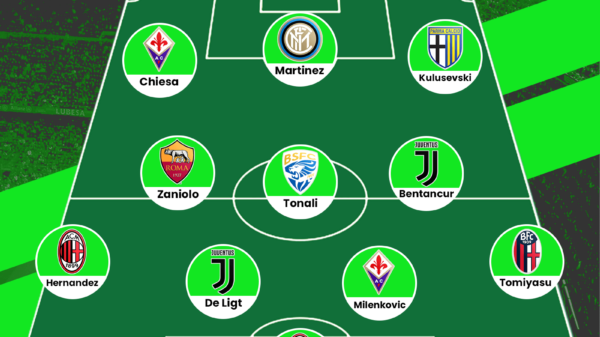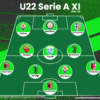Daniel Gutman has an in-depth look at the Kings of the Set Piece, Hellas Verona focusing on how the Italian side are so lethal from dead ball situations.
Few teams can lay claim to being the absolute best at an aspect of football. Who is to say that a team in the second division of Germany does not score better goals than Juventus, or that a bottom-table Ligue 1 side does not string together better pass combinations than Barcelona? The nature of football is that it is tough to quantify, and aside from a few choice statistics–which themselves have emerged only recently–clubs are scarcely able to call themselves “the best”. In Italy, one little team has quietly claimed one of rare quantifiable mantles.
Hellas Verona finished bottom of the Serie A table this recently-concluded campaign, and did not win a match until February. Over the course of the season, it made a name for itself as Serie A’s resident punching bag. The club was mathematically relegated well before the last day, but realistically had no chance of staying up once it hit its sixth consecutive match without a victory back in September of 2015.
Verona supporters had little to celebrate this season, their beloved team edging closer and closer to Serie B with each passing weekend. In their despair, fans likely passed over one of their club’s great achievements. Though rock bottom at the end of the season, the Gialloblu still emerged as kings; the kings of the set piece.
Over the course of their campaign, through free kicks and corner situations, Verona notched 18 goals. The tally was bested only by the mighty Real Madrid in La Liga and Bordeaux in Ligue 1 across Europe’s top five leagues. Verona scored more goals from set pieces than it did from open play, a stunning feat unmatched in Europe’s top championships. The club managed a meager 10 open play goals across the entire season, meaning that its players scored almost twice the amount from dead-ball situations as from the general run of the match. In fact, even when penalties are added into the fold, Verona still have more goals from set pieces than all the rest of their conversion situations combined.
Such a statistic is not one never seen before. Teams that struggle with breaking down opponents often find themselves only able to score consistently from dead-balls. After all, even the best tactically organised clubs can find themselves at the mercy of a laser-accurate free kick or a glancing header from a corner.
What sets Hellas Verona apart from others who have enjoyed set piece success is not simply their ratio compared to all other scoring situations. The quality of the goals was also incredibly high. They did not come from lucky shots rattling off the bar or accidental backwards headers. Each one of the 18 set-piece strikes are owed to tightly organised, well communicated setups.
With an abundance of high quality freekicks and corners to choose from, selecting a choice few to be analysed presented no small challenge. All the strikes had their merits, but three in particular stood out as the best Verona had to offer, exemplifying all the positive approaches the club took to their dead-ball situations.
Freekick vs Atalanta. September 20, Matchday 4
Freekicks are generally situations that teams are least prepared to defend against. There is an abundance of ways for the free-kick taker to create a goal, from a shot to a cross to a dummy play. Guesswork plays a significant role in dealing with set-pieces; the distance to goal, ability of the taker, and positioning of defenders all play a role in figuring out the forthcoming dead-ball situation.
When Verona got an opportunity 32 meters from the Atalanta goal, La Dea correctly anticipated the character of the impending freekick. Leaving only one defender as the wall and sending the rest to mark Gialloblu players at the top of the box, the understanding was that a swinging cross would be the weapon of choice.
Seemingly all the Verona players were accounted for, marked by at minimum one Atalanta defender. All except for Eros Pisano, a lone figure (circled in red) at the right edge of the 18-yard area.
Three meters separated Pisano from Atalanta’s closest defender Maxi Moralez (circled in orange), who was oblivious to the fullback’s presence. His back to the eventual goalscorer, La Dea’s best-positioned player to deal with Pisano had no idea the 29-year-old was even there. Freekick taker Federico Vivani noted the lack of a mark on his teammate, and sent a high, loping cross over to the far post.
Using the element of surprise to his advantage, Pisano ran in a slightly curved path, avoiding being caught out by his mark. Sprinting past Moralez from behind, he was able to connect with the cross before his opponent could respond. Hitting a flying header from a full sprint, Pisano’s appearance seemingly out of nowhere managed to catch goalkeeper Marco Sportiello unaware as well, allowing the defender’s header to sail into the back of the net with no interference.
This goal was not the first dead-ball situation from which Verona scored that season, as one was notched in a draw with Torino a week prior. It was, however, the first superbly-organized freekick of the campaign, setting a precedent for set-piece quality throughout the club’s ill-fated forthcoming months.
Freekick vs Inter Milan. February 7, Matchday 24
Verona’s 3-3 draw with Inter Milan was a master-class of exploitation. A pair of corners and a freekick from the Gialloblu showed Inter coach Roberto Mancini the weaknesses of his club’s set-piece routines. The visiting Nerazzurri had shown before that defending against dead-balls was not their strong suit, leading their hosts to pursue a course of action that would best take advantage of the weakness. Verona players several times made shots that could have otherwise been better polished, hoping for Handaovic to palm the ball out of play to create a corner.
Players also ran into crowded situations more than would be expected, aiming to get tripped up by a defender to grab a freekick near the box, which would greatly increase Verona’s chances of finding a way to steal an unlikely point or three. 15 minutes into the first half, the Gialloblu got the opportunity they were looking for. A freekick roughly 30 meters from Handanovic’s goal, mere minutes after scoring off a corner kick, provided a window for Verona to find a way into the match.
Eros Pisano was once again the set-piece hero, scoring a header courtesy of a delivery from Juventus loanee Luca Marrone. Much like his header against Atalanta, the defender used his superior positioning abilities to gain an upper hand over Inter defenders and surprise his way to a goal. Mohamed Fares and Marrone both stepped behind the dead-ball, and when the whistle blew Fares ran over the ball, faking out the players near the box and sending them running towards the goal.
Pisano hung back for a fraction of a second, a momentary pause allowing him to be free of his mark. As Marrone sent the ball up towards the far post, Pisano’s delay in pushing forward meant he ran unimpeded through the sea of players, none of them bothering to check on a player they thought was far behind them. Three Inter defenders were within arm’s reach of the right back, but none were able to prevent his header.
The intelligence demonstrated in the pause, the apparent insignificance of waiting slightly too long, describes Verona’s approach to set-piece with remarkable clarity. The goals are not flashy, nor are they accidental results of disorganised messes. The microscopic, hundredth-of-a-second pauses are just a small part of the well-oiled machine that is the Gialloblu dead-ball setup: elementary on the surface yet vastly complex.
Corner vs Inter Milan. February 7, Matchday 24
Inter’s set-piece incompetence and Verona’s command of offensive dead-ball scenarios was heavenly for the underdogs. After going up 2-1 early in the first half, the Gialloblu were one opportunity away from extending an unlikely, narrow lead to an almost certainly unassailable advantage. A corner situation a quarter of the way through the second period provided the hosts with precisely the opening they needed.
After conceding twice on set-pieces, Inter were wary of letting in an embarrassing third from their scrappy opponents. As two-time dead-ball deliverer Luca Marrone stepped up to the corner flag, the entire Nerazzurri team found itself in the box. All eleven players, from Samir Handanovic to Mauro Icardi, shared a common objective. In that instant, preventing a two-goal deficit was all that mattered.
Unfortunately for Inter, all their preparation and efforts to stop a third Verona goal resulted in tragedy. With the sheer number of bodies in the box, it seemed impossible that anybody would be able to get enough of the ball to accurately direct it. In some measure, this was true. None of the 12 players within spitting distance of the six-yard box managed to touch the ball. It was not Inter’s defending of players close to the goal that condemned Handanovic to a third conceded goal. What doomed the Nerazzurri was a minor oversight in player marking. While most of Inter’s players and a sizable portion of Verona’s jostled for space close to the net, a solitary figure stood calmly at the top of the box.
Artur Ionita was one of the few players not being marked as Marrone stepped up to the ball. 18 yards away from the goal and with over a dozen players several yards away from him, it made sense that Inter’s priorities were to make sure nobody in a yellow kit close to the net had the space to stretch out their arm, rather than concerning themselves with one far away.
Eder (circled in orange), the Inter player closest to Ionita (circled in red), had his back to him, more concerned with a potential pass to an unmarked Filip Helander (number 5 in front of Ionita) than the eventual goalscorer’s chances of making an impact. This provided the Moldovan international with the freedom to demonstrate his lethality.
As Luca Marrone sent the corner up towards the top of the six-yard box, Ionita rushed forward. Catching defenders by surprise and worming his way to connect with the curling cross, the defensive midfielder headed the ball past a helpless Handanovic. Like Pisano’s header earlier in the match, Inter defenders had no idea Ionita was even there until they saw him celebrating with his teammates. The “ambush” factor once again yielded dividends for the Gialloblu.
These three goals are but a small fraction of the 18 Verona put in the back of the net throughout their campaign. From these, and all the others, similarities can be drawn, creating an outline of the successful strategies used by the club to score, even when outclassed in open play. The first is the usage of the under-exploited element of surprise. In an age where open play is valued magnitudes above set-pieces and teams rarely practice extremely organised dead-ball scenarios, far too many clubs share an identical outlook on freekicks and corners.
Corner kicks are seen as the most–aside from penalties–straightforward part of a match. You send a cross into the crowd of bodies in the box and hope your players jump higher than your opponents. Freekicks contain slightly more nuances, but are also largely symmetrical across most clubs. Either the ball is shot, or it is sent forward into the same sea of players just like a corner, once again with the hope your team is aerially superior.
Contrastingly, Verona approach these situations with the detail level and carefulness of a master artist. With most defenses expecting the standard set-piece into the group of players in or near the box, the Gialloblu threw in minor tweaks that ended up throwing off their opponents. Eros Pisano showed against Inter that even the seemingly insignificant act of pausing for a brief moment during a freekick is enough to guarantee unimpeded passage through on goal. Pisano also demonstrated, along with Ionita, that positioning oneself in an atypical point prior to the set-piece sequence beginning leads to unprecedented movement opportunity.
By starting the dead-ball scenario in an area the opposition is not accustomed to watching, Ionita and Pisano were able to rush in and score. Defenders, after all, cannot get in the way of players they have no idea are there.
The second part of the strategy is one applied away from matches. It is implemented in training day in and day out. Practising these situations is what separates clubs that know how to score from dead-balls from those that simply pray for a lucky goal during a corner. Making these strategies part of a player’s instinct, their second nature, is what makes a team truly great. These types of clubs do not come along often, and certainly not with the level of attention that Verona placed on their set-pieces.
Though Verona will spend their upcoming season in the second division, they have left behind a legacy that Serie A clubs would do well to take note of. Set-pieces can be the key to success even when nothing else goes right. By making your team approach each freekick, each corner, with the belief that their strategies, forged through tens of hours of training, will pay off, a new and relatively unexplored area of exploitation will open itself for plundering. All coaches have to do is look to Verona.
Written by Daniel Gutman
- Hellas Verona: Kings of the Set Piece - July 20, 2016
































































